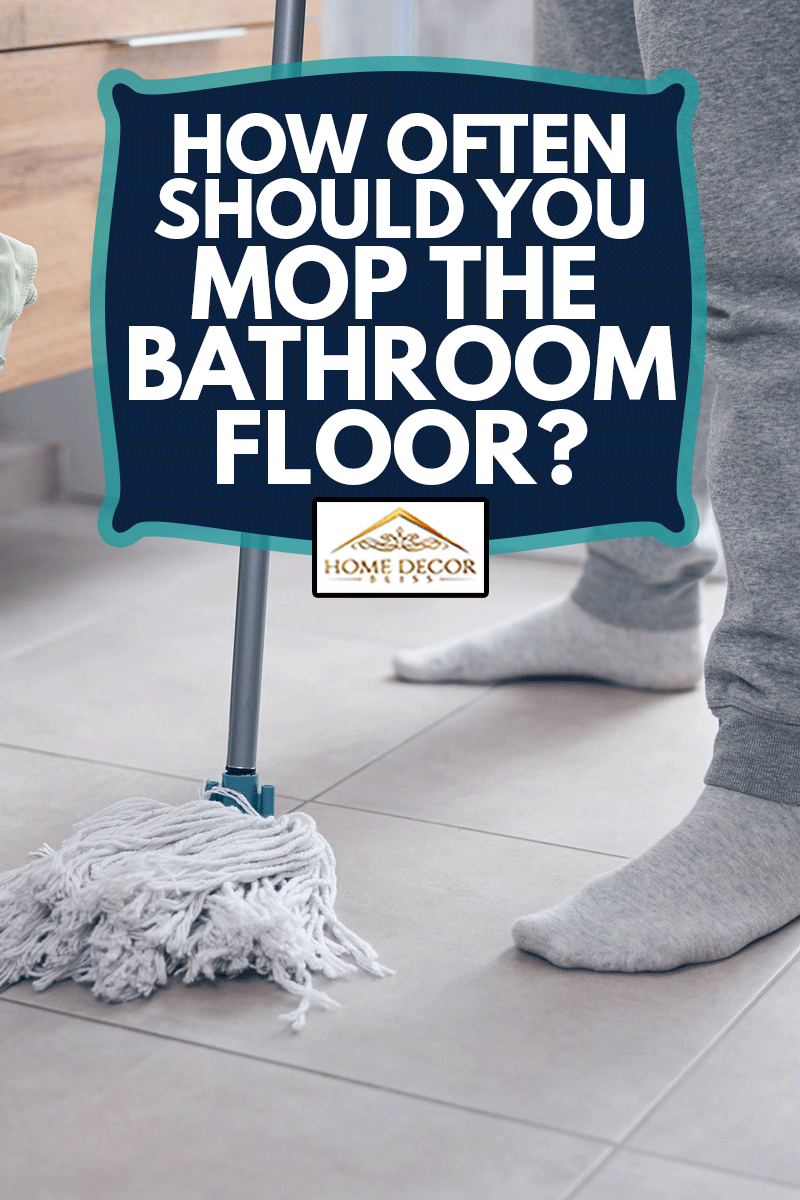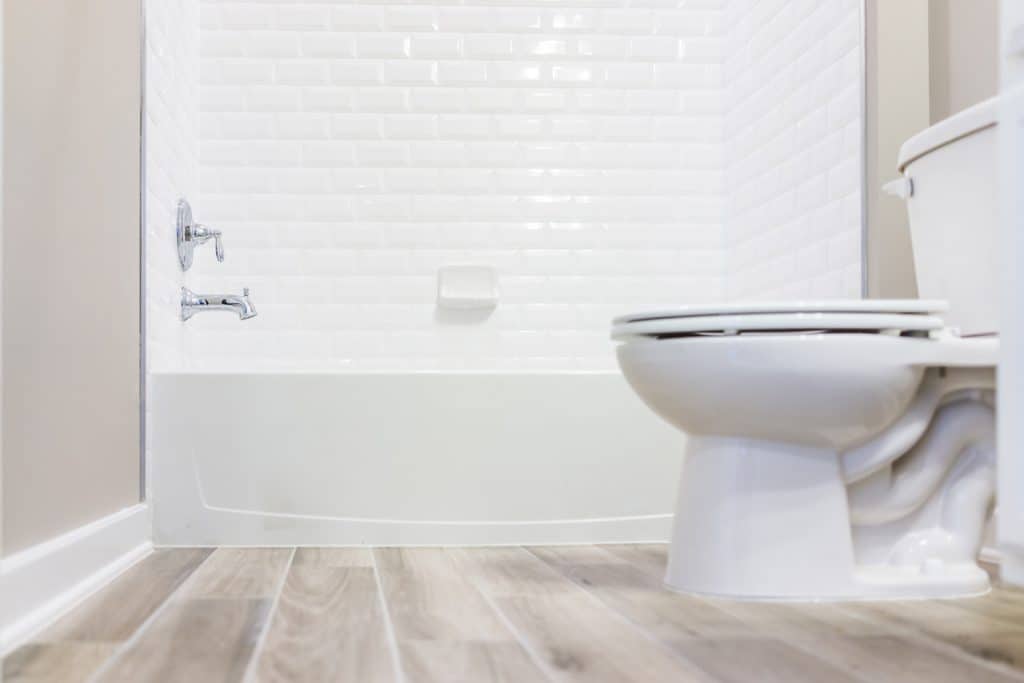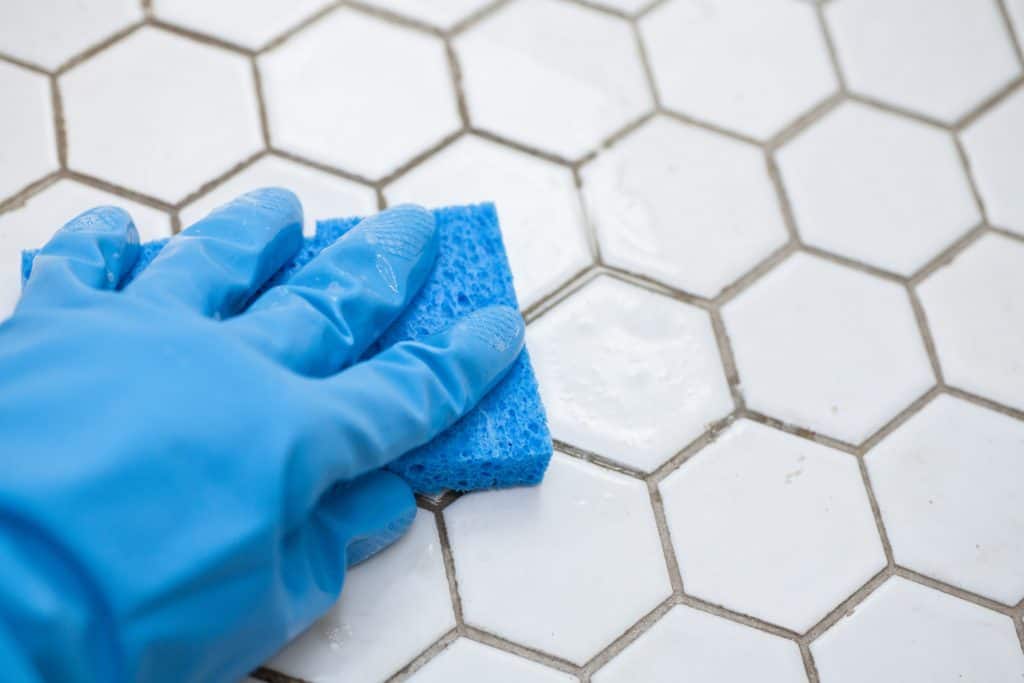Cleaning your bathroom may not be the most exciting chore, but it's essential when maintaining a healthy household. Bathrooms are generally one of the dirtiest rooms in your home, just from normal daily use. Heavily used bathrooms see a lot of foot traffic, especially from bare feet or even wet feet after a shower. Keeping your floors clean and sanitized from germs will help prevent the spread of bacteria to your family and around the rest of the home. So how often should you be mopping your floors to keep them clean?
Regularly used bathrooms should be mopped once a week. For less frequently used bathrooms, every other week is sufficient.
With an endless number of mops and solutions that boast about their ability to give your floors the best clean, it can be overwhelming to determine what is best for your bathroom. We've done the research to guide you through the most effective frequency and products to keep your bathroom floors clean.

How Often Should Bathroom Floors Be Mopped?
We sometimes add affiliate links and content that was curated and created by our team with the help of advanced ai tools to help showcase the best design styles.

Between the other surfaces in your bathroom, like the sink or toilet, the floors are one of the cleanest in the room. However, a freshly mopped bathroom floor can quickly become dirty with one flush of the toilet.
Main bathrooms in your home that see frequent use should be mopped at least once a week, and see a deep cleaning once a month. For guest bathrooms or bathrooms that don't get much use, every other week or once a month will be sufficient if the floors aren't seeing much traffic.
Does mopping actually clean?
When done correctly, mopping is the best way to keep hardwood and tile floors clean. Using a clean mop head, warm water, and cleaning solution meant for floors is what makes mopping so effective. When dirty water or a mop head with a build-up of dirt and grime is used, you will just be moving dirty water across your floors, making them worse.
What is the best way to clean a bathroom floor?
For a frequently used bathroom, maintaining clean floors between deep cleanings is a must. When doing basic upkeep, you should remove any items from the bathroom floor, including the trashcan and any rugs. Then, sweep the floor to remove any loose dust or dirt, making sure to sweep along the baseboards.
Once you've swept your floors, use a clean mop and a mixture of hot water and floor cleaner to clean up any stuck-on grime. Allow the floor to dry before placing items, like rugs, back onto the floor.
Deep Clean

Even with weekly upkeep, bathrooms should be getting a deep cleaning at least once a month. This is a time to scrub all bathroom surfaces, including the bathtub, sink, and floors.
When deep cleaning your bathroom floors, you'll still want to remove anything sitting on the bathroom floor and thoroughly sweep up any loose dirt and dust.
To get a deeper clean, before you mop, use a scrub brush in warm, soapy water to scrub the floors, corners, and baseboards of the bathroom. Ensure to hit all the nooks and crannies, like around the toilet and along the bottom of the sink or vanity. The abrasiveness of the scrub brush will work to loosen up any grease and grime before mopping.
If your bathroom has grout, a grout cleaner and a smaller scrub brush will remove any dirt or discoloration from the grout. Do this while you are scrubbing the floors.
After scrubbing the floors, use a clean mop, hot water, and a mopping solution to clean away anything the scrub brush loosened. If there appears to be a great deal of grime, rinse the mop and take a second pass over the floors.
Once the floor has dried, you can use a steaming mop to sanitize the floor. These mops use heat and steam to kill any bacteria left behind. Before placing rugs on the floor, make sure there are no wet spots along the baseboards and corners, as this can promote mold and bacteria growth.
Top Cleaning Supplies

Having the most effective supplies will ensure you are getting the most thorough clean when cleaning the bathroom.
Mop
For a bucket and mop option, it doesn't get much better than a spin mop. Spin mops are the best at removing excess water from the mop head. This is important because it prevents dirty mop water from being pushed around the floors and helps to ensure the floors get completely dry to avoid bacteria growth.
Spray mops are also excellent options for mopping your bathroom floors because their mop pads are removable and washable, so keeping them clean is as easy as tossing them into your next load of laundry. This spray mop by Rubbermaid allows you to customize your own cleaning solutions, so you aren't stuck purchasing specific products that may not clean how you need them to.
Steam mops allow you to clean and sanitize your floors, which is the best choice when cleaning bathroom floors that attract bacteria and germs. Steaming mops also feature removable pads that can be tossed in the washer.
This Bissell can be used for both mopping and sanitizing, saving you space and time.
Cleaning Solution
If you prefer a cleaner you can make at home; there's a simple recipe that works hard at cleaning your floors but probably won't give you that fresh lemon-scented smell that a store-bought cleaner will.
In a bowl or spray bottle, combine 1 cup of baking soda, 1/2 cup dish detergent, 1/2 cup warm water, and 2 tablespoons of white vinegar. This is an excellent solution for breaking down grime, but the vinegar smell can be overpowering until it's rinsed away and dries.
For a cleaning solution that is quick yet very effective, Bona Hard-Surface cleaner is the best for tile. This spray bottle requires little effort, spray directly onto the floor and run a mop over it. There's no rinsing required.
For a concentrated formula with top-notch performance, Mrs. Meyer's Multi-Surface Cleaner provides a deep clean on floors and tons of other surfaces in your home. A little goes a long way and will leave your bathroom smelling fresh and clean.
If you want to give your grout a good cleaning, Grout-Eez safely cleans white and colored grout.
When should I replace my mop head?
When a mop head is appropriately cared for, such as cleaned, disinfected, and stored only when dry, it should last you two to three months. This lifespan can shorten if your mop is being used more frequently in heavily soiled areas or if it develops bacteria build-up from being left in water.
How do you clean a mop head?

Keeping your mop head clean is going to help keep your floors clean as well. If you're using a dirty mop head, you're moving dirt, grime, and bacteria around instead of cleaning it up. To make sure you're getting the cleanest clean from your mop, there are several ways you can clean your mop head in between floor cleanings.
Soaking
For the least amount of hassle put into the cleaning, you can soak your mop head in hot water mixed with a half cup of bleach or a cup of white vinegar. Soak it for 10-30 minutes, rinse the mop with hot water, ring out, and leave it out to dry.
This method will work best for mops that don't require very deep cleaning. For instance, if you are cleaning a low-traffic bathroom like a guest bath or you live alone, this is great for a once-a-week cleaning.
Deep Clean
When you have extra high traffic bathrooms that get a lot of use, deep cleaning for your mop head will help kill and prevent bacteria from developing. This is also a great once-a-month method for lower-traffic bathrooms where they use their mop heads.
Start by removing any excess dirt by spinning your mop head in a bucket of clean, hot water. Making sure the mop head hits the bottom and sides of the bucket when you're spinning will help knock off any loose dirt.
Next, fill your bucket with a bleach mixture, using hot water and 1/2 cup of bleach. Allow the mop head to soak for up to 30 minutes.
After the mop has soaked, repeat the first step of spinning the mop in a bucket of clean water. However, this time add dish detergent to the hot water.
Once you feel your mop is clean, you can alternate rinsing and wringing out the mop head until the soap is gone. If you think that your mop head isn't sufficiently clean, you can repeat the process of soaking it in bleach and then clean it again with dish detergent.
Tips
Never leave your mop head soaking in water, clean or dirty, for longer than a couple of hours. Allowing it to sit in water will cause bacteria to form on your mop head.
Always make sure your mop head is completely dry before putting it away. Storing a damp mop head will also create bacteria build-up.
In Closing
Keeping your bathroom floors clean will prevent the transference of germs and bacteria to loved ones or other areas of your home. How frequently you mop your floors should increase when there is heavier use of a bathroom and can decrease in the lesser-used bathrooms.
For more on keeping bathroom floors clean, check out these posts:






